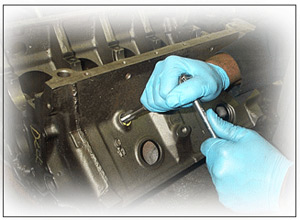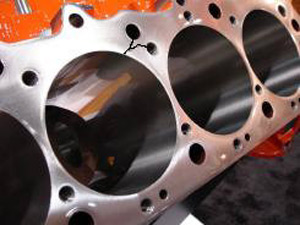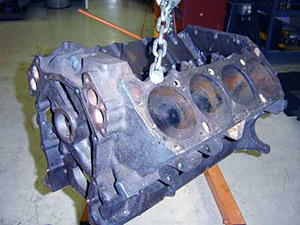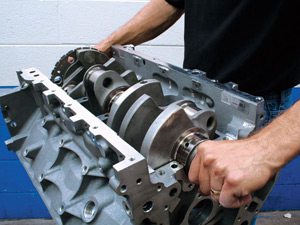By Andy Jensen
 First, you want to look for cracks on the water jacket area and in the lifter valley area. If the block has ever been frozen, this is where cracks will show up. Next, look for cracks around the main webs, these are hard to spot when the block is greasy, but we are just looking for obvious cracks now.
First, you want to look for cracks on the water jacket area and in the lifter valley area. If the block has ever been frozen, this is where cracks will show up. Next, look for cracks around the main webs, these are hard to spot when the block is greasy, but we are just looking for obvious cracks now.
If the webs check out OK, unbolt the main caps and look at the bearing seats for evidence of a spun bearing. If one or more of the seats look rough, and the material is blackened from heat, the block is not going to be suitable for performance use.
Provided the seats all look OK, place the main caps back on the block. They should snap into the block registers nice and snug. If they fit loosely, the caps will slide around under pressure and could cause a main bearing failure. After the main caps pass inspection, start checking for core shift.
Core shift occurs at the foundry when the blocks are being cast. The internal core will shift from the external core during casting, resulting in an “off center” block. The biggest problem with this is an un-uniform cylinder bore thickness. It is of utmost concern when using large overbores or very high horsepower.

The easiest way to check for core shift is to look at the cam and lifter bores. If they are in the center of the cast bulkhead in the block, the core didn’t shift too much, if they are way off center the core did shift. A block with a moderate amount of core shift will still be OK for performance use.
Once you’ve found a good core to start with, the first thing that needs to be done is get it cleaned. There are two basic options here: hot tanking or baking and peening. Peening does a much nicer job of removing scale and rust from the block. Peening is how we clean all of our race blocks, but it does cost a few dollars more, and it does rough up the machined surfaces a little. So, if you are planning on getting away with as little machine work as possible, hot tanking may be better for your job.
After the blocks are cleaned, check it for cracks using magnetic particle inspection. Again, they’ll be a lot easier to spot on a clean block. If no cracks are found, it’s time to start machining the block.
For stock rebuilds or very mild performance use, start by checking the cylinder head mounting surface. If it’s flat and not warped, it won’t need to be “decked.”

Next, check the main bearing housing bores, if they are in close alignment and the diameter is in the factory specified tolerance, it won’t need to be align honed. If everything checks out OK, all the block should need is bored and honed to fit whatever piston you are using.
For high horsepower applications, you must be more particular about tolerances, so we recommend decking the block. By doing this, you can achieve the desired surface finish for whatever gasket is used. Ensure that the decks are parallel to the crankshaft axis, and at the proper height to get the quench that you want, (quench is the distance from the flat portion of the piston, to the flat portion of the cylinder head).
When boring a block that has been decked, the cylinder bore becomes perfectly perpendicular to the crankshaft axis, which will help ring seal and reduce side loading of internal engine parts. When honing a high horsepower block, a torque plate should be used. This is a thick steel plate that is torqued to the deck with the cylinder head fasteners, this simulates a head being torqued to the block. Torquing a head down on a block creates imperfections in a cylinder bore, by using a torque plate, you can hone them to near perfection.

The main bearing housing bores are machined with a boring tool from the factory. This leaves a moderately rough finish for the bearing to rest against, so the actual contact area is reduced to where the bearing contacts the high spots on the surface of the bearing seat. For any high horsepower application, the block should be align honed. This ensures that the bores will be in perfect alignment and also provides a very flat, smooth bearing seat.
Depending on the application, budget and horsepower levels, it is sometimes necessary to use billet splayed bolt main caps. These are much wider than stock caps and the outer bolts reach into the sides of the block adding to the strength and reliability of the main webs.
This should cover most of the major stuff you’ll need to be concerned with. There are some oil and cooling system modifications that could be beneficial, but they are very application specific and should be determined by your needs.
Tech Tip courtesy of Jensen Engine Technologies.
